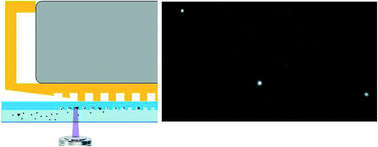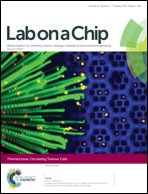A microdevice for rapid optical detection of magnetically captured rare blood pathogens
Abstract
Sepsis diagnosis requires development of methods to identify rare pathogen cells in small samples of human blood. Magnetic beads functionalized with pathogen-binding ligands have been used to rapidly isolate microbes from blood; however, it is commonly difficult to optically detect the captured species because the excess numbers of beads required for pathogen binding physically interfere with light transmission after they have been concentrated. Here we describe a microdevice that uses microfluidics combined with optimized magnetic field concentrators and magnetic beads coated with a generic blood opsonin to efficiently capture unknown blood pathogens and spread them into a thin layer suitable for automated optical detection. Using this device, we have been able to detect fungal pathogens in less than three hours after sample collection compared to days with current technology, and with an extremely high sensitivity (<1 cell mL−1 of human blood).


 Please wait while we load your content...
Please wait while we load your content...